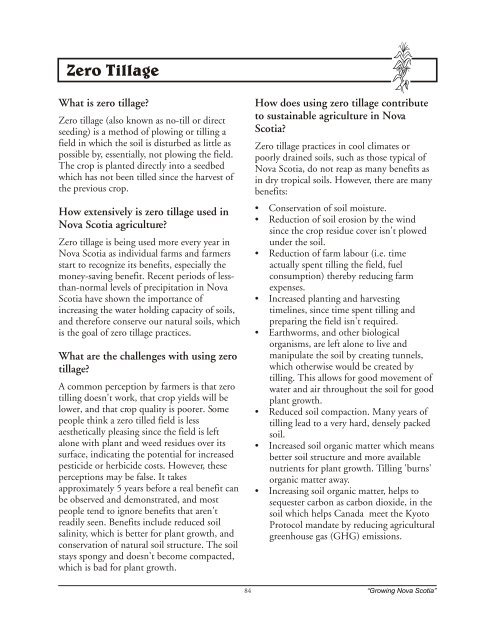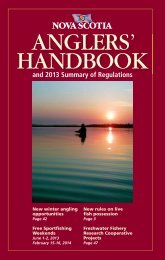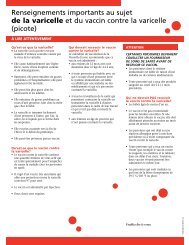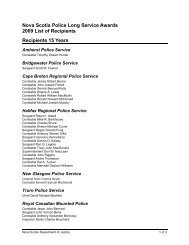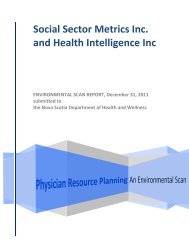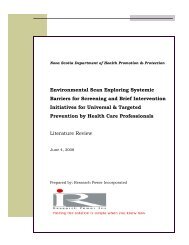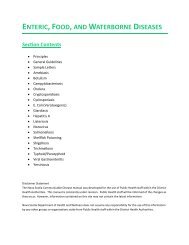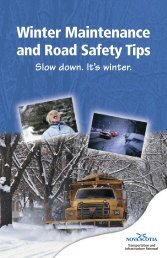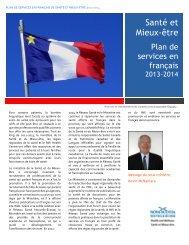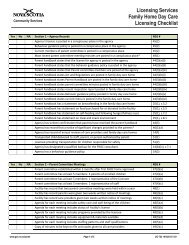Create successful ePaper yourself
Turn your PDF publications into a flip-book with our unique Google optimized e-Paper software.
<strong>Zero</strong> <strong>Tillage</strong>What is zero tillage?<strong>Zero</strong> tillage (also known as no-till or directseeding) is a method <strong>of</strong> plowing or tilling afield in which the soil is disturbed as little aspossible by, essentially, not plowing the field.The crop is planted directly into a seedbedwhich has not been tilled since the harvest <strong>of</strong>the previous crop.How extensively is zero tillage used in<strong>Nova</strong> <strong>Scotia</strong> agriculture?<strong>Zero</strong> tillage is being used more every year in<strong>Nova</strong> <strong>Scotia</strong> as individual farms and farmersstart to recognize its benefits, especially themoney-saving benefit. Recent periods <strong>of</strong> lessthan-normallevels <strong>of</strong> precipitation in <strong>Nova</strong><strong>Scotia</strong> have shown the importance <strong>of</strong>increasing the water holding capacity <strong>of</strong> soils,and therefore conserve our natural soils, whichis the goal <strong>of</strong> zero tillage practices.What are the challenges with using zerotillage?A common perception by farmers is that zerotilling doesn't work, that crop yields will belower, and that crop quality is poorer. Somepeople think a zero tilled field is lessaesthetically pleasing since the field is leftalone with plant and weed residues over itssurface, indicating the potential for increasedpesticide or herbicide costs. However, theseperceptions may be false. It takesapproximately 5 years before a real benefit canbe observed and demonstrated, and mostpeople tend to ignore benefits that aren'treadily seen. Benefits include reduced soilsalinity, which is better for plant growth, andconservation <strong>of</strong> natural soil structure. The soilstays spongy and doesn't become compacted,which is bad for plant growth.How does using zero tillage contributeto sustainable agriculture in <strong>Nova</strong><strong>Scotia</strong>?<strong>Zero</strong> tillage practices in cool climates orpoorly drained soils, such as those typical <strong>of</strong><strong>Nova</strong> <strong>Scotia</strong>, do not reap as many benefits asin dry tropical soils. However, there are manybenefits:• Conservation <strong>of</strong> soil moisture.• Reduction <strong>of</strong> soil erosion by the windsince the crop residue cover isn't plowedunder the soil.• Reduction <strong>of</strong> farm labour (i.e. timeactually spent tilling the field, fuelconsumption) thereby reducing farmexpenses.• Increased planting and harvestingtimelines, since time spent tilling andpreparing the field isn't required.• Earthworms, and other biologicalorganisms, are left alone to live andmanipulate the soil by creating tunnels,which otherwise would be created bytilling. This allows for good movement <strong>of</strong>water and air throughout the soil for goodplant growth.• Reduced soil compaction. Many years <strong>of</strong>tilling lead to a very hard, densely packedsoil.• Increased soil organic matter which meansbetter soil structure and more availablenutrients for plant growth. Tilling 'burns'organic matter away.• Increasing soil organic matter, helps tosequester carbon as carbon dioxide, in thesoil which helps Canada meet the KyotoProtocol mandate by reducing agriculturalgreenhouse gas (GHG) emissions.84 “Growing <strong>Nova</strong> <strong>Scotia</strong>”
85 “Growing <strong>Nova</strong> <strong>Scotia</strong>”


